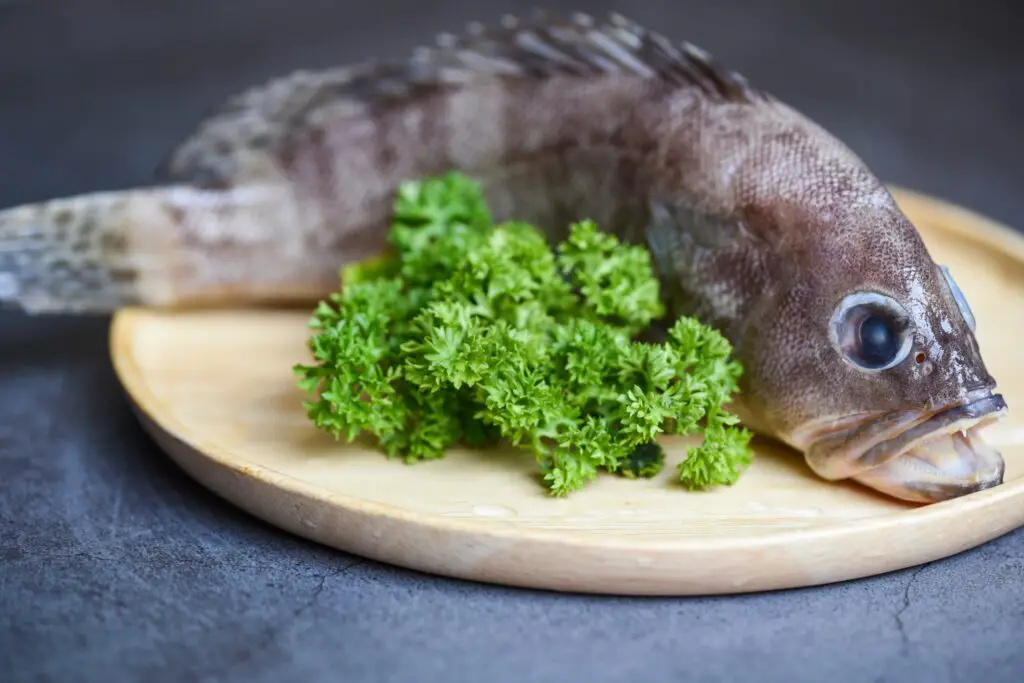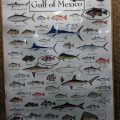The misty grouper, also known as the yellow edge grouper, is a popular fish to catch and eat. It is a fish that can be seen year-round and is considered a delicacy in many places. It is a type of fish found in the western Atlantic Ocean, particularly in the Gulf of Mexico and the Caribbean Sea. It belongs to the family Serranidae, which includes other types of groupers and sea basses.
The scientific name for misty grouper is Hyporthodus flavolimbatus, and it kind of looks like Snowy Grouper but with one different feature. Since not many people know about this species, it gets mistaken for other grouper species, such as goliath grouper. The fish not only tastes good but can also be caught year-round in Florida, as well as many other places.
What does Misty Grouper look like?
Appearance-wise, the fish has some similarities to the Snowy Grouper. It is a grouper that, just like other groupers, is not the most exciting looking.
The grouper has a big head compared to its body, with the lower jaw extended outwards more than the upper jaw. It has somewhat of a longer and more elongated body than some other groupers that are more round, like the goliath grouper. However, it is still rounded, which is why it can be mistaken for goliath grouper. Color-wise, the body of the misty grouper is grayish brown on the back and sides, and the color gradually turns paler towards the stomach of the fish.
The fish also has a thin pale blue line that extends from the eyes to the corner of the cheek. This is not as noticeable but is only seen when more attention is paid to the fish. What makes this fish different from the snowy grouper is the yellow edge, as its name suggests. This fish has pectoral fins and dorsal fins that have a yellow edge towards the end. The tail of the misty fish also has yellow edges as well as around its eyes; the edges are yellow too.
When it comes to the juvenile fish, a young misty grouper has pale spots all over its body that fade as it matures. The young fish also has a saddle-like black blotch on the bottom of the tail fin, which again fades with time.

What is the Lifespan of a Misty Grouper?
The lifespan of most grouper fish is pretty long. However, it is very rare to see the grouper reach its maximum lifespan considering the tough competition for resources such as food in the ocean.
It is observed that the average lifespan of the misty or yellow edge grouper is 15 years, during which the fish keeps growing, but the maximum age of the grouper that was caught was 85 years. Therefore, there is a huge difference in average age and maximum age. The misty grouper matures when it reaches the ages of 6 to 8 years, although, in some places, it can mature as soon as it reaches the 5 year mark.
It could be that the older misty grouper is harder to find or that the fish is eaten or caught before it can reach its maximum age. Regardless, the grouper could keep living for a very long time as long as it survives, even more than 85 years.
What is the Size of the Misty Grouper?
Since it occupies the same water as goliath grouper, it does get pretty big in size. Since the fish has a long lifespan, it means that it keeps growing with time.
Depending on the age and where the fish is caught, its size can range drastically. However, most misty groupers are 26 inches to 45 inches in size and weigh 8 lbs. to 40 lbs. Of course, this is small when compared to the giant grouper or goliath grouper. The maximum size of the misty grouper that was caught is more than this. The largest fish was 45 inches in size and 48 lbs. when it comes to weight.
What is the Habitat of the Misty Grouper?
The habitat of misty grouper is the same as goliath grouper. Knowing the exact habitat of the fish helps anglers and fishermen catch the fish and not waste time wandering about.
The grouper is found in many places, from North Carolina to Florida, including the Gulf of Mexico, southern Brazil, and parts of the Caribbean. The misty grouper is mostly found along the continental shelf break and throughout the Gulf of Mexico. These are solitary fish that are often found wandering these areas. In the ocean, they occupy a particular area.
Although located in places with open waters, the fish is found in deeper waters. In fact, juvenile fish can be found near the shallow part of the ocean, but as the fish age, they go deeper and deeper underwater. This could also be the reason why a very large and old misty grouper has not been caught yet, as the more it ages, the harder it is to catch one. The adult grouper is found at depths between 410 feet and 984 feet.
In the ocean, you will find the fish near rocky, sandy, and muddy bottoms, which is their preferred habitat for hiding and eating. Basically, the fish prefers soft bottoms because it borrows and makes its own home in these areas. Most groupers prefer coral reefs to hang around and look for food, and misty groupers are also one of them.
What is the Diet of Misty Grouper?
The misty grouper is known to be carnivorous. This means that the fish gets its nutrients from other living organisms and cannot get any nutrients from algae or other water plants like herbivorous fish. Most groupers are actually omnivorous or opportunistic eaters, which means that they eat whatever they can find, whether it is living organisms or plants, to survive.
The misty grouper prefers eating invertebrates, like crabs. The stomach of these fish shows that their diet mostly consists of crabs. However, if they do come across small fish near where they are living, they will not let the fish get away either. Therefore, the diet of the yellow edge grouper consists of crabs and fish, mostly and occasionally squids, crustaceans, lobsters, and shrimp as well. In fact, the fish can also be seen feeding on octopuses.
Misty grouper usually stays safe and only attacks prey that is small enough to fit their mouth and not put up a fight. There are some fish that hunt other larger or similar-sized fish, but Misty Grouper is wise enough to stick to smaller organisms that will not put up a fight.
What Does Misty Grouper Taste like?
Now, the misty grouper is not only good for catching, but it is actually considered a delicacy in places where it is found. The grouper can be eaten and enjoyed in a wide variety of ways. In fact, it is caught strictly for selling as food as well.
This fish is lean and moist with a slightly sweet flavor. Like some of the best fish, the misty or yellow edge grouper has its own distinct taste that you can only experience if you eat the fish fresh. The meat also has a firm texture and huge flakes, which make it super easy to grill as it does not fall apart like some other fish. Since the fish is very moist, it is perfect for beginner cooks because it is almost impossible to dry the fish out. It is a very juicy and forgiving fish that can be enjoyed in a variety of ways.
If one had to describe the taste of the fish, it would be a cross between halibut and bass. Some people even consider the meat of yellow edge grouper to be the best tasting when it comes to grouper meat. If you want to experience grouper meat, misty grouper should be the first one that you do try.
Although the fish has its own flavor, it can be boiled, steamed, baked, or added to soups and other dishes. The fish is excellent at retaining flavor and absorbing the taste of the marinades. The flavor of the fish also depends on how fresh the fish is and where it was caught. Often, wild, caught fish does not taste great because it depends on their diet, and thus, they can taste kind of muddy. For the best experience, get fresh and best-quality misty fish from a trusted source.
How to catch Misty Grouper in Florida?
This fish can be caught in Florida. In fact, it is caught a lot there, and most groupers can be caught there. However, catching the fish depends a lot on its behavior and habitat, which vary from species to species.
To catch misty grouper, you need non-stainless steel circle hooks, especially if using natural baits. As well as a dehooking device. Without this basic equipment, you cannot catch any fish, let alone the misty grouper. To prevent overfishing, only four of these fish are allowed to be taken home, according to the Gulf of Mexico Fishery Management Council, which dictates how many yellow edge groupers can be caught in Florida.
To attract this fish, it is best to have live bait. A live bait moves around so the fish will think it is alive and is more likely to come out. Moreover, live bait smells stronger, so it will get the grouper out of its hiding spot. To make it seem like it is a real fish, you can also move it around a bit or even hold still can get the misty grouper to attack it.
Since yellow-edge groupers like to occupy deeper waters, the hook needs to be thrown pretty deep near muddy areas of the ocean and very offshore. It is important to bring multiple baits like squid, crabs, and any other smelly fish. The misty grouper is also pretty active at night, but it is much harder to see at night, which makes it harder to catch them.
To catch them, you need a strong hook and heavy line that should be able to reel the grouper in. As you know, this fish is pretty large and aggressive. It will put up a fight, and if the hook and line are not strong enough, it can easily break. If you do not want that, bring a good-quality, heavy-duty hook and line.
When to Catch Misty Grouper in Florida?
The misty grouper is available year-round because it does not go into hiding during extreme weather like some other fish. However, it is best to catch these fish during the spawning season, as that is when they are most active, and there are more fish available as well. Also, the yellow-edged grouper is a vulnerable species due to overfishing, so you cannot catch too many of them at once.
The grouper spawns from February to November, and the peak season for reproduction is from March to September. This is when the fish should be caught, and it will be easier to catch them as well.
Since the grouper is hermaphrodites, all the fish are born female and only turn male after reaching maturity. The grouper reaches maturity when it reaches six to eight years. Not all female fish turn into males; only the ones that are bigger and stronger than the others do so. This is why the fish do not reproduce as often because there are more female fish than male ones, and it takes time for them to mature, change sex, and then reproduce.
Conclusion
Misty or yellow edge groupers are very fun and unique species of groupers. They are mostly caught for commercial reasons because their meat is very tasty and famous. But the species is vulnerable, so it is very rare to find it and taste it. Now you know what this fish looks like, its habitat, size, and other such facts.











